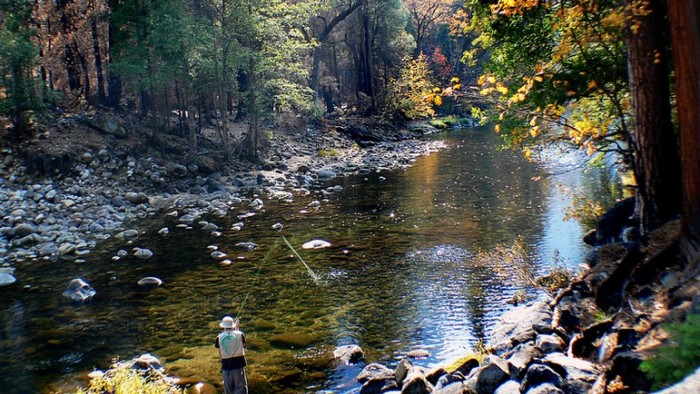California Clears Path for New Watershed Funding

In September, Governor Jerry Brown (D-CA) signed AB 2480 into law. This bill established that “source watersheds are recognized and defined as integral components of California’s water infrastructure.” The conservation think tank Pacific Forest Trust created the bill together with its author, Assemblymember Richard Bloom (D-Santa Monica).
This may seem to be a nominal change in water policy for the state. But it is unusual because the law allows for the maintenance and repair of source watersheds. This way, they can be eligible for the same forms of financing as traditional water-utility infrastructure.
The bill mentions five Northern California watersheds. Problems due to community development and forest management have negatively impacted these watersheds. The bill would provide more tools for the state to protect and restore them. More than 24 million people in California are affected by drought as of Feb. 10. So some stakeholders hope that AB 2480 will ensure the long-term viability of the state’s water resources.
Watershed Value
Watersheds are a critical component of the water-resources systems that deliver clean water and sanitation services. Yet, public spending programs have historically focused on reservoir systems and water-utility infrastructure such as piping and treatment facilities. They have done this rather than emphasizing maintenance and repair of natural infrastructure such as watersheds.
The value of natural infrastructure in ensuring water quality and quantity is receiving greater attention both in the United States and abroad. The United Nations Sustainable Development Goals address the need for quality and sustainability of water resources worldwide to provide clean water and sanitation.
The national Water Infrastructure Finance and Innovation Act (WIFIA) of 2014 includes watersheds as an eligible area for infrastructure investment. In 2015, the Obama Administration issued an executive order directing federal agencies to integrate natural infrastructure and ecosystem services into decision making.
The Sierra Nevada Conservancy has called attention to the need for increased funding and more efficient management to restore forested areas and improve water quality and quantity in the region. The organization contends that lack of funding for forest management leads to more intense fires that increase erosion.
This erosion results in sediment-laden runoff that degrades water quality. It also damages infrastructure by silting up reservoir systems. Funding made possible by AB 2480 would provide restoration and maintenance. This would improve management of forest systems in the source watersheds.
[[{"fid":"2901","view_mode":"default","fields":{"format":"default","field_file_image_alt_text[und][0][value]":"Sequoia","field_file_image_title_text[und][0][value]":""},"type":"media","attributes":{"alt":"Sequoia","height":"265","width":"400","style":"float:right","class":"media-element file-default"}}]]
Nonprofit Success
The success of AB 2480 is a coup for environmental groups in California, which are concerned about climate change. Laurie Wayburn, Pacific Forest Trust’s president, said “Mr. Bloom agreed this natural water system infrastructure was as critical for the state as the built infrastructure. And the state needed to be treating this natural infrastructure the way we treat the dams, canals and pumps with regular repair and maintenance.”
As the bill took shape, Pacific Forest Trust engaged the water-stakeholder community early and often, gaining broad support from organizations such as Audubon California, California League of Conservation Voters, and Trust for Public Lands.
While there was no formal opposition to the bill, critics have been quoted by Water Deeply as expressing concern about the use of conservation easements and the lack of emphasis on management for overall ecosystem health.
Future Prospects
As the effects of climate change threaten water security, governments are looking for ways to invest in sustainable water resources.
A recent market survey by Forest Trends found that global investment in green infrastructure for water by governments, water utilities, companies and communities spent nearly $25 billion in 2015. This is an 11.8 percent increase above 2013. Over 96 percent of that spending was in the form of direct payments from governments to landowners “to protect and restore water-critical landscapes.”
With the passage of AB 2480, California can now fund watershed maintenance and restoration through revenue bonds rather than general obligation bonds, which rely on the state’s taxing power.
Wayburn said the “cost effectiveness of this approach to enhancing the reliability, quality, quantity and timing of our water supplies really was compelling.” This encouraged legislators to pass the measure.
However, the state still needs to raise the appropriate financing and develop a watershed-investment plan to guide projects. The timetable for an investment plan is forthcoming. Wayburn said the program will also “require a much more landscape level permitting of restoration to cover the millions of acres that are involved in a timely way.”
It is unclear what effect, if any, the watershed maintenance costs will have on the price of water provided to consumers.
To comment on this article, please post in our LinkedIn group. You may also email the authors of any of Conservation Finance Network's articles via our contact form or contact us via Twitter.